Chapter
2
Fractal Generation of
the Classical Hexagonal Hierarchies
Concepts from
fractal
geometry embrace the entire geometry of classical central place
theory.
One type of fractal iteration sequence alone, a self-similarity
transformation,
produces all possible central place nets. This alignment
presents
more than mere technique for a verification of a geometry of central
places
(although it does do that, too); the geometry of the central place
model
is well-known and has been clearly, and comprehensively, discussed in
Michael
Dacey's 1965 article (Dacey 1965).
The conceptual material here reveals an exact procedure for the merging
of two separate theories: one from pure mathematics and one from
economics and geography. In so doing, it suggests, in general,
the
power of one to enrich the other through the lodging of one discipline
in the house of the other, and in particular, a theory in its own right
derived from associating mathematically-specialized central place
concepts
with mathematically-broader fractal concepts.
In this
chapter,
we show in detail the alignment of fractal geometry with classical
central
place theory. In subsequent work, we illustrate how this geometry
extends into far-flung realms to solve existing unsolved problems of
classical
central place theory and probe directions for further theoretical
discovery
and empirical application. The alignment of the existing
classical
material with fractal geometry is of interest in its own right; far
more
important, however, is the benchmark that this alignment
creates--classical
central place geometry serves as a field check for the fractal maps
prior
to the use of these maps as guides in the realm of theoretical
geography.
"Fractals Take a
Central Place"
In the
material below, we illustrate, using a hexagon as an initiator,
different
selections of generators applied to the initial hexagon, to produce the
different hexagonal hierarchies of classical central place theory
(based
on original concept and work of S. Arlinghaus (1985); see link).
In the previous chapter we formed central place landscapes by moving
from
small hexagons to large ones; here, we reverse the process and dissect,
using the self-similarity transformation, a large hexagon to create the
smaller ones. In both processes, the results correspond
exactly.
The art is in generator selection, and it is simply that art that is
presented
in this chapter. Later work will delve into the mathematical
foundations
of that art.
The
K=3 Hierarchy
When an hexagonal initiator is chosen and a two-sided generator, with
included
angle of 120 degrees, is used to make successive replacement of the
sides
of the hexagon (as in the animated Figure 2.1a), the outline of the
next
layer of the K=3 central place hierarchy is generated (the
black
lines in Figure 2.1a suggest interior connections). The
replacement
sequence applies the generator in an alternating pattern to the outside
and then to the inside of the initiator. When the original
generator
is scaled down, with shape preserved, and applied in the outside/inside
sequence to the newly formed blue polygon, the next lower level central
place K=3 hierarchy is formed (as in the animated Figure
2.1b).
The second, blue polygon contains three scaled-down hexagons,
self-similar
to the first hexagon (Figure 2.1a); the red polygon in the animation
sequence
contains three shapes self-similar to the blue polygon (Figure 2.1b),
and
27 (or 3 cubed) hexagons self-similar to the original hexagon (Figure
2.1b).
The invariant of 3, in the K=3 hierarchy, is replicated in this
particular fractal iteration sequence.
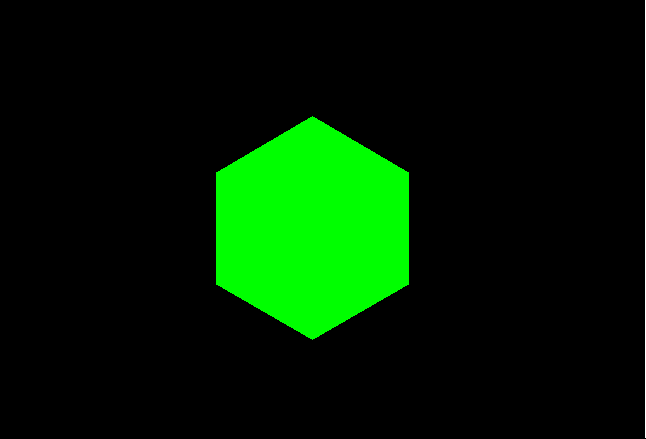
Figure
2.1a.
Animated K=3 fractal iteration sequence: first
transformation
using a two-sided fractal generator applied successively to sides of
the
hexagonal initiator. |
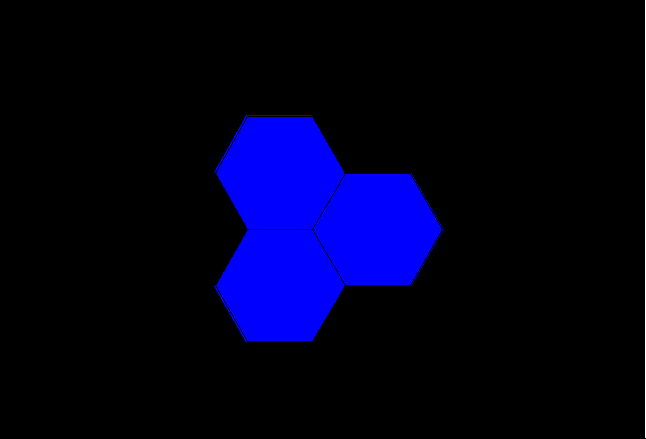
Figure
2.1b.
Animated K=3 fractal iteration sequence: second
transformation
using a scaled-down two-sided fractal generator applied successively to
sides of the blue polygon generated in Figure 2.1a. |
It
remains to determine if the polygons generated in Figure 2.1 will in
fact
fit together to form the broad central place landscape of arbitrary
size
suggested in
Figure
1.5. To that end, we stack the layers generated above using
the
fractal iteration sequence to form a tile of layers centered on the
single
polygonal initiator (Figure 2.2). Click here
to see a virtual solid model of the tile with which the reader can
interact.
Click
here
to see a virtual translucent model of the tile with which the reader
can
interact. Consider the screen captures below from those virtual
reality
models.
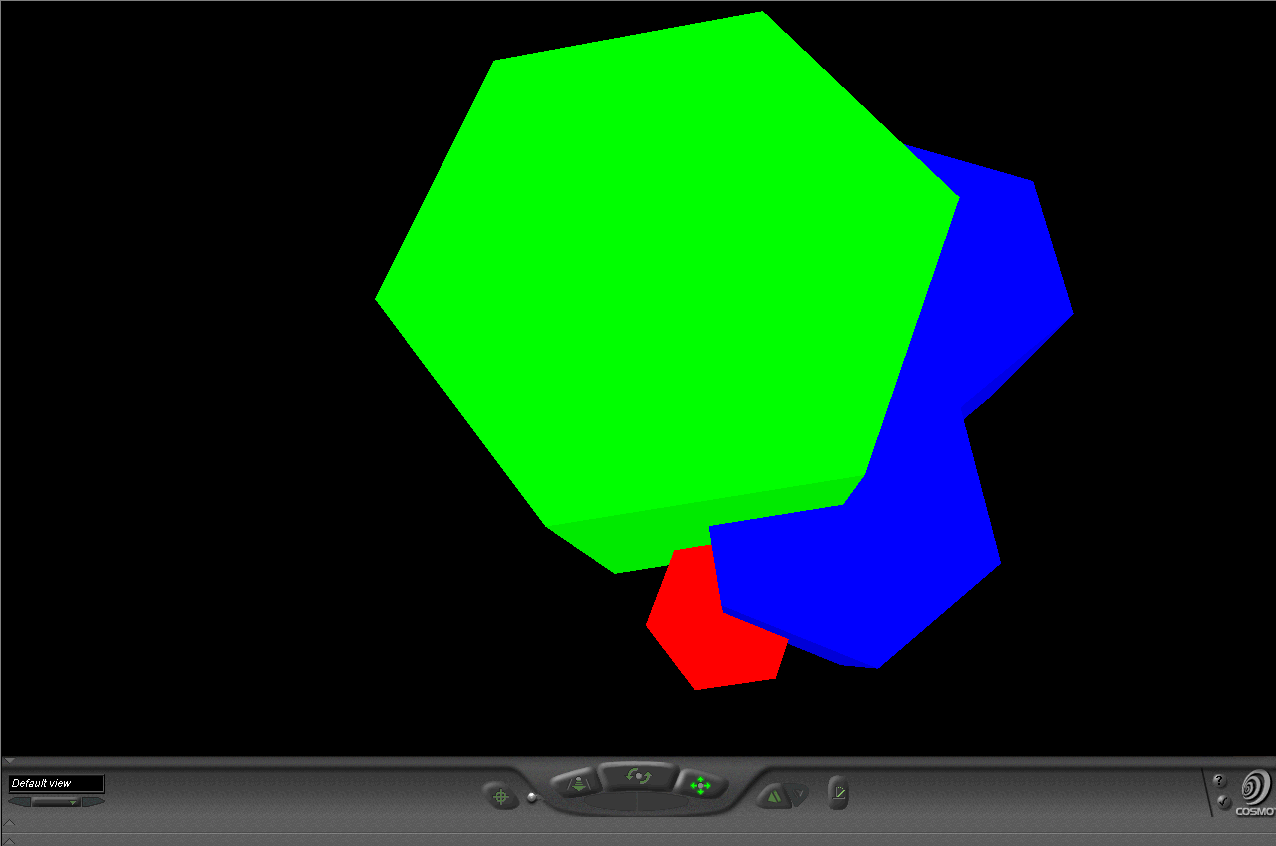
A screen shot
from
the virtual world linked to this image. Click on the image to
enter
that world! |
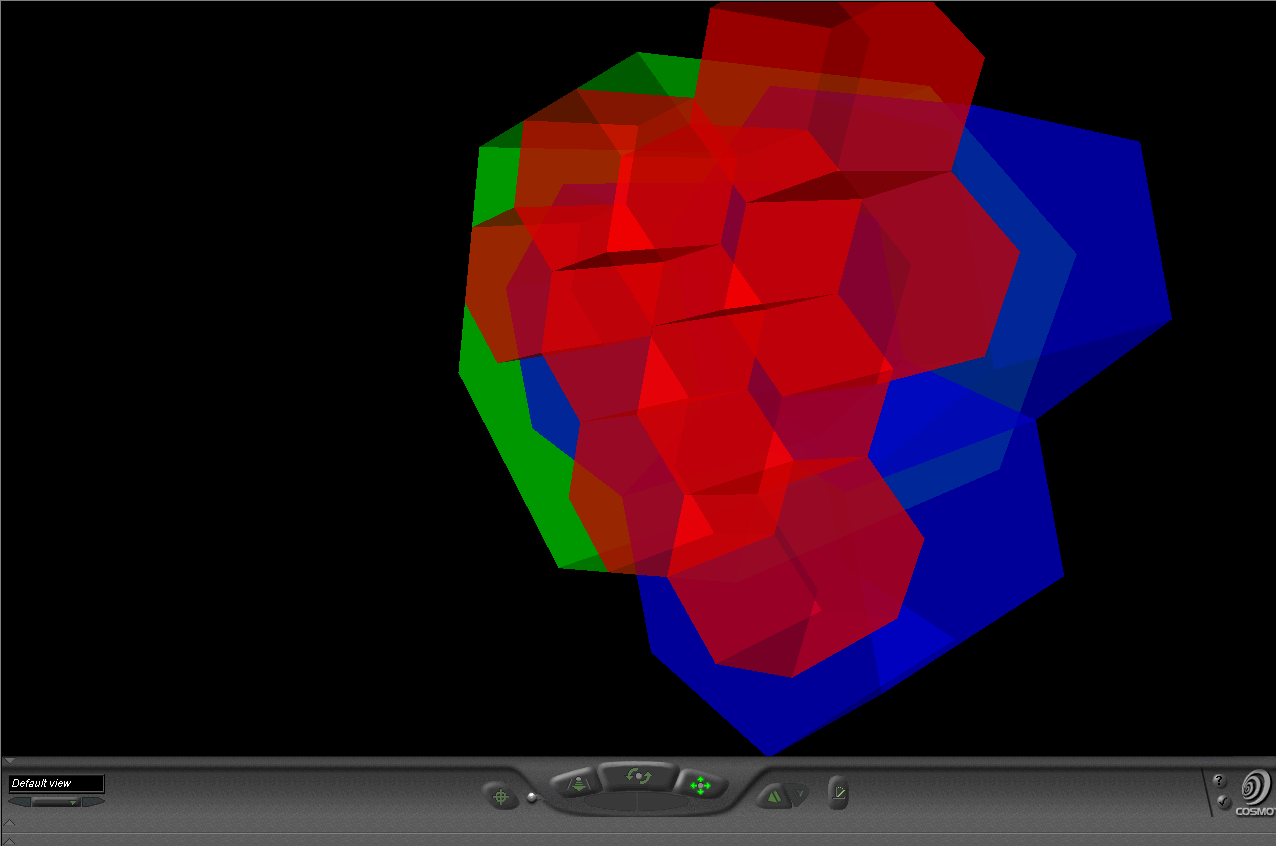
A screen shot
from
the virtual world linked to this image. Click on the image to
enter
that world! Translucent solids permit one to see relationships
among
layers of the hexagonal hierarchy while travelling through the solids. |
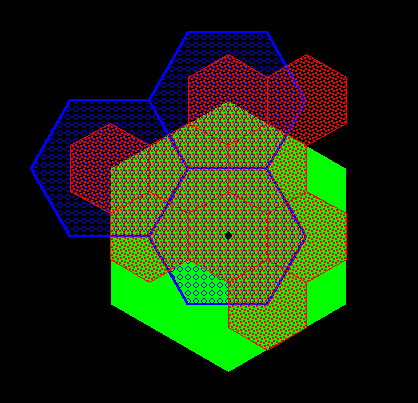 Figure
2.2.
Fractally generated layers stacked on a single hexagonal tile.
Click
here
to see a virtual solid model of the tile with which the reader can
interact.
Click here
to see a virtual translucent model of the tile with which the reader
can
interact.
Figure
2.2.
Fractally generated layers stacked on a single hexagonal tile.
Click
here
to see a virtual solid model of the tile with which the reader can
interact.
Click here
to see a virtual translucent model of the tile with which the reader
can
interact. |
Finally,
we tile the plane using the hexagonal initiators, from Figure 2.2 with
the attached stack of smaller hexagons, to discover if the superimposed
structure also fits together perfectly (Figure 2.3). Hexagonal
tiles
are used to cover the plane without gaps, as is the case with the
sample
of green hexagons in Figure 2.3a. The hexagons mesh perfectly to
cover the plane (Theorem of Gauss).
In Figure 2.3b, the green outline of the hexagons remains. Each
of
the solid green hexagons has had the fractal generator above applied
and
the consequent superimposed blue tiles come into view sequentially in
this
animation. Again, the fit is exact, as we had hoped it might
be.
Finally, in Figure 2.3c, the blue outline only is retained from Figure
2.3b (along with the green outline from Figure 2.3a). The final
fractally
generated layer derived from the blue polygons of Figure 2.3b comes
into
view in shades of red (or yellow/gold for contrast). The final
layer
of hexagonal base of unit hexagons appears last. The fit is
perfect:
each green hexagon contains the equivalent of four blue hexagons and
each
blue hexagon contains the equivalent of four red hexagons. The
fractal
generation procedure created exactly the classical central place
landscape
of Figure
1.5 (return here using the Back button on your
browser).
As the animation proceeds in Figure 2.3, further layers of the
fractally
generated hierarchy, attached to the tile in Figure 2.2, come into view
illustrating an exact meshing of tiles at all levels to form a K=3
hierarchy.
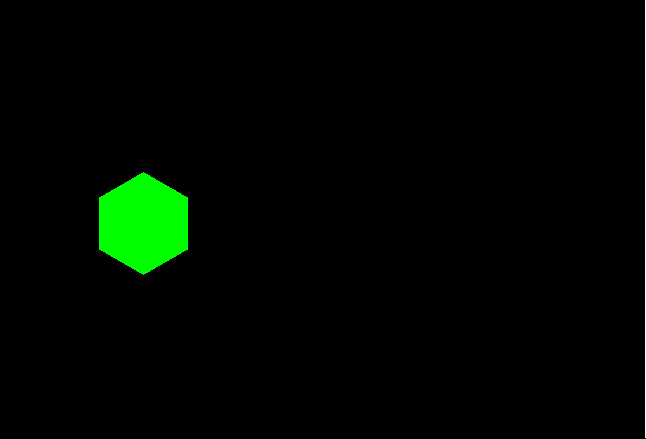
Figure
2.3a. Green layer on tile from Figure 2.2 fits exactly to
tile the plane (Theorem of Gauss). |
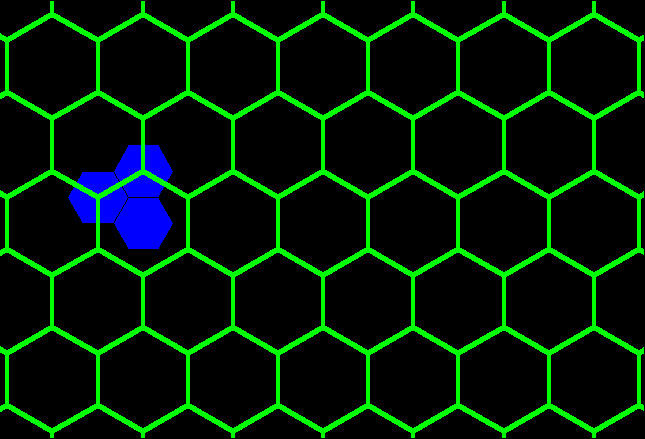
Figure
2.3b.
Blue
layer on tile from Figure 2.2 fits exactly to form classical
K=3
landscape. |
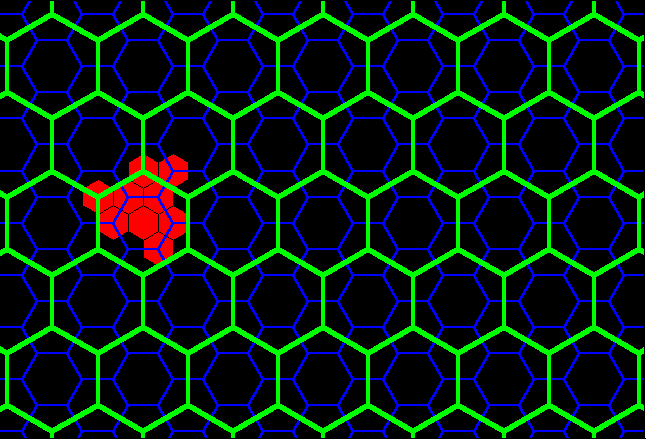
Figure
2.3c.
Red layer on tile from Figure 2.2 fits exactly to form classical K=3
landscape. |
The K=4 Hierarchy
When an hexagonal initiator is chosen and a three-sided generator, with
included angles of 120 degrees and shaped in the form of an isosceles
trapezoid,
is used to make successive replacement of the sides of the hexagon (as
in the animated Figure 2.4a), the outline of the next layer of the K=4
central place hierarchy is generated (the black lines in Figure 2.4a
suggest
interior connections). The replacement sequence applies the
generator
in an alternating pattern to the outside and then to the inside of the
initiator. When the original generator is scaled down, with shape
preserved, and applied in the outside/inside sequence to the newly
formed
blue polygon, the next lower level central place K=4 hierarchy
is
formed (as in the animated Figure 2.4b). The second, blue polygon
contains four scaled-down hexagons, self-similar to the first hexagon
(Figure
2.4a); the red polygon in the animation sequence contains four shapes
self-similar
to the blue polygon (Figure 2.4b), and 64 (or 4 cubed) hexagons
self-similar
to the original hexagon (Figure 2.4b). The invariant of 4, in the
K=4
hierarchy, is replicated in this particular fractal iteration sequence.
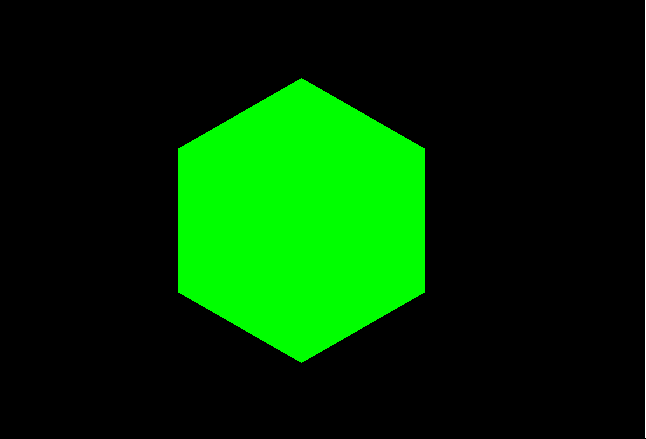
Figure
2.4a. Animated K=4 fractal iteration
sequence:
first transformation using a three-sided fractal generator applied
successively
to sides of the hexagonal initiator. |
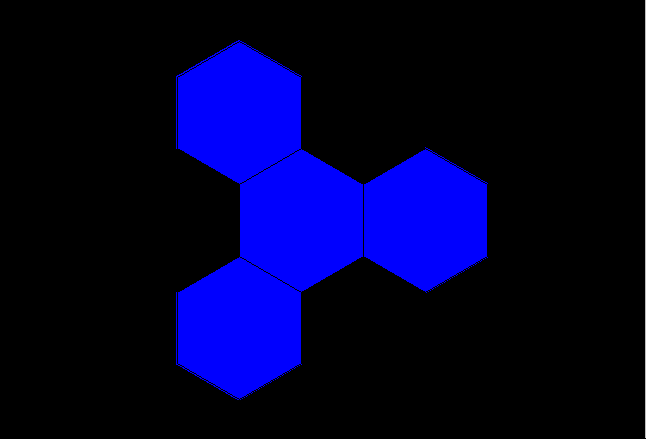
Figure
2.4b. Animated K=4 fractal iteration
sequence:
second transformation using a scaled-down three-sided fractal generator
applied successively to sides of the blue polygon generated in Figure
2.4a. |
It
remains to determine if the polygons generated in Figure 2.4 will in
fact
fit together to form the broad central place landscape of arbitrary
size
suggested in
Figure
1.7. To that end, we stack the layers generated above using
the
fractal iteration sequence to form a tile of layers centered on the
single
polygonal initiator (Figure 2.5). Click
here
to see a virtual solid model of the tile with which the reader can
interact.
Click
here
to see a virtual translucent model of the tile with which the reader
can
interact. Consider
the screen captures below from those virtual reality models.
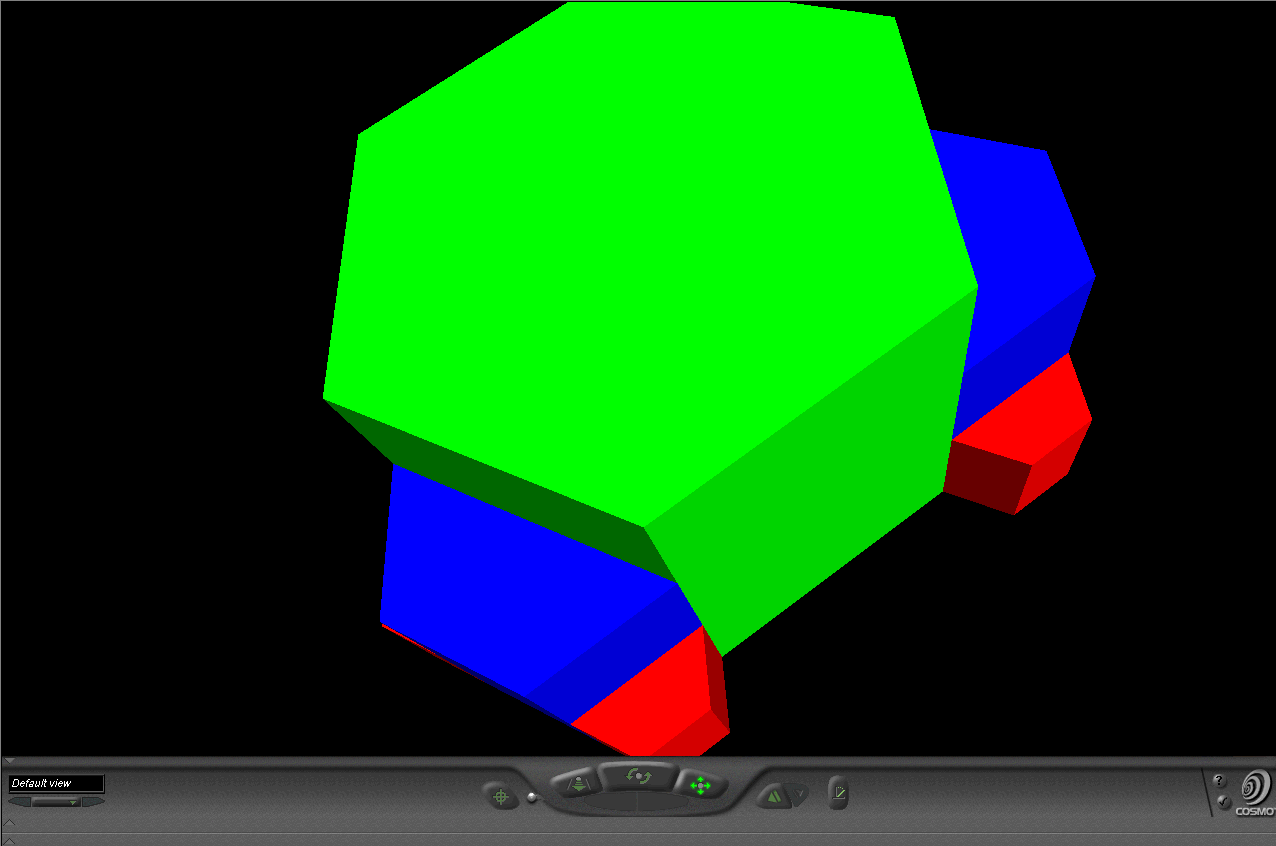
A screen shot
from
the virtual world linked to this image. Click on the image to
enter
that world! |
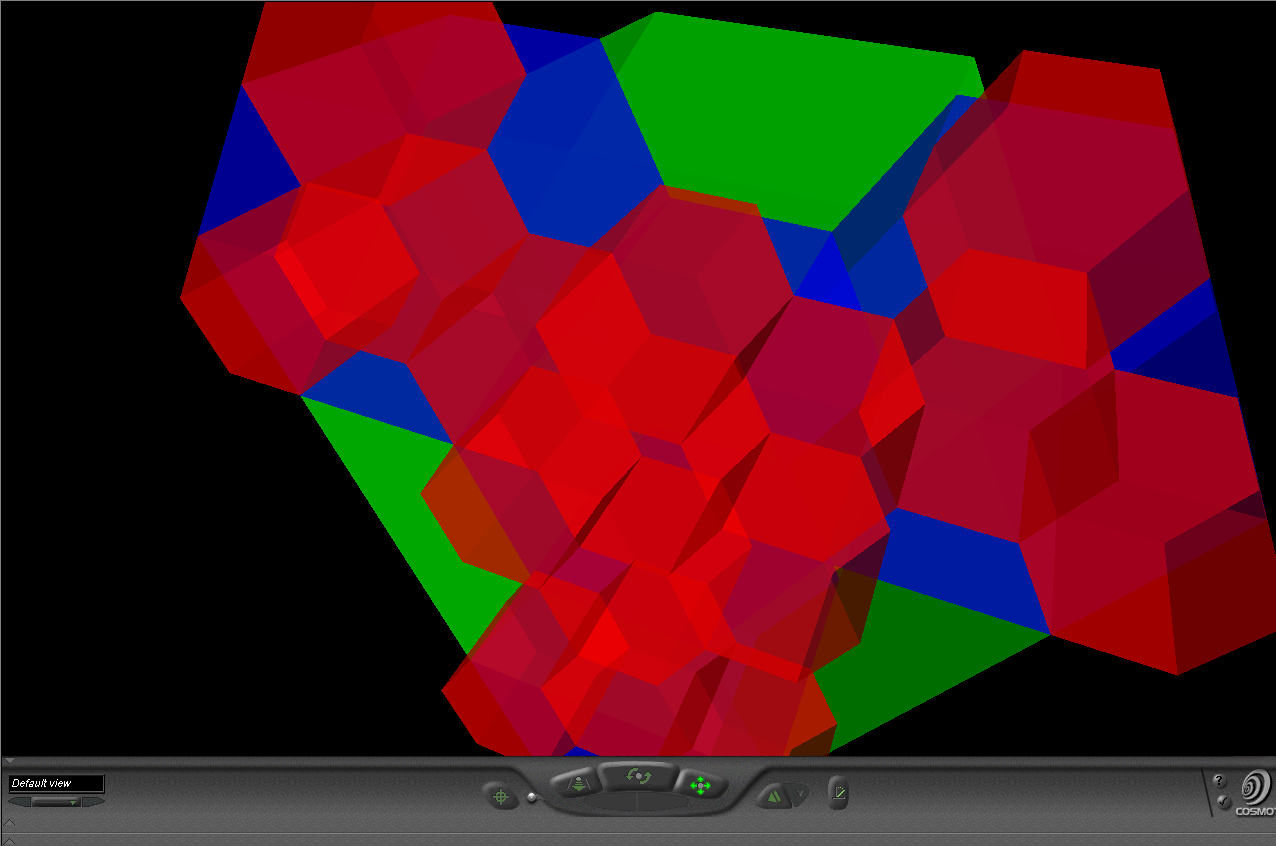
A screen shot
from
the virtual world linked to this image. Click on the image to
enter
that world! Translucent solids permit one to see relationships
among
layers of the hexagonal hierarchy while travelling through the solids. |
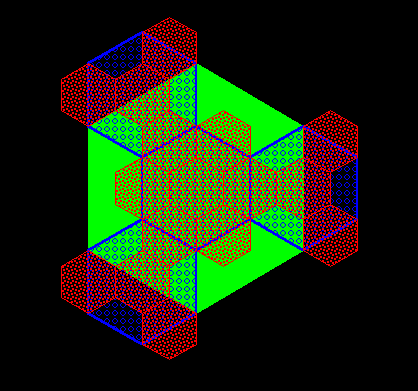
Figure 2.5.
Fractally generated layers stacked on a single hexagonal tile.
Click
here
to see a virtual solid model of the tile with which the reader can
interact.
Click here
to see a virtual translucent model of the tile with which the reader
can
interact. |
Finally,
we tile the plane using the hexagonal initiators, from Figure 2.5 with
the attached stack of smaller hexagons, to discover if the superimposed
structure also fits together perfectly (Figure 2.6). Hexagonal
tiles
are used to cover the plane without gaps, as is the case with the
sample
of green hexagons in Figure 2.6a. The hexagons mesh perfectly to
cover the plane (Theorem of Gauss).
In Figure 2.6b, the green outline of the hexagons remains. Each
of
the solid green hexagons has had the fractal generator above applied
and
the consequent superimposed blue tiles come into view sequentially in
this
animation. Again, the fit is exact, as we had hoped it might
be.
Finally, in Figure 2.6c, the blue outline only is retained from Figure
2.6b (along with the green outline from Figure 2.6a). The final
fractally
generated layer derived from the blue polygons of Figure 2.6b comes
into
view in shades of red (or yellow/gold for contrast). The final
layer
of hexagonal base of unit hexagons appears last. The fit is
perfect:
each green hexagon contains the equivalent of four blue hexagons and
each
blue hexagon contains the equivalent of four red hexagons. The
fractal
generation procedure created exactly the classical central place
landscape
of Figure
1.7 (return here using the Back button on your
browser).
As the animation proceeds in Figure 2.6, further layers of the
fractally
generated hierarchy, attached to the tile in Figure 2.5, come into view
illustrating an exact meshing of tiles at all levels to form a K=4
hierarchy.
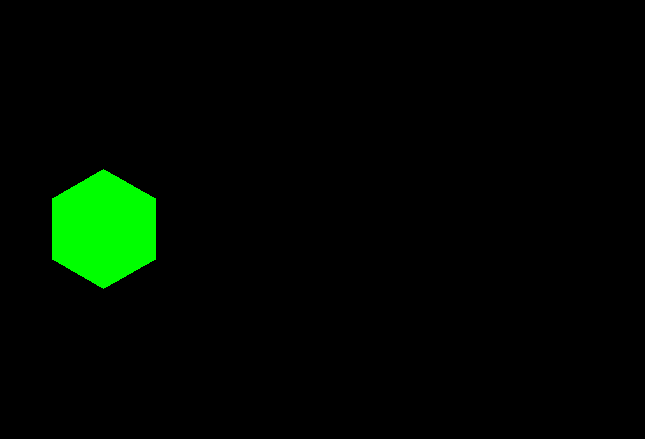
Figure
2.6a. Green layer on tile
from
Figure 2.5 fits exactly to tile the plane (Theorem of Gauss). |
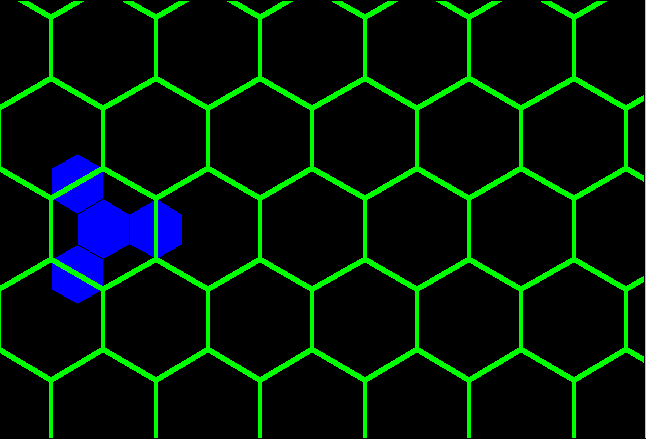
Figure
2.6b.
Blue layer on tile from Figure 2.5 fits exactly to form classical K=4
landscape. |
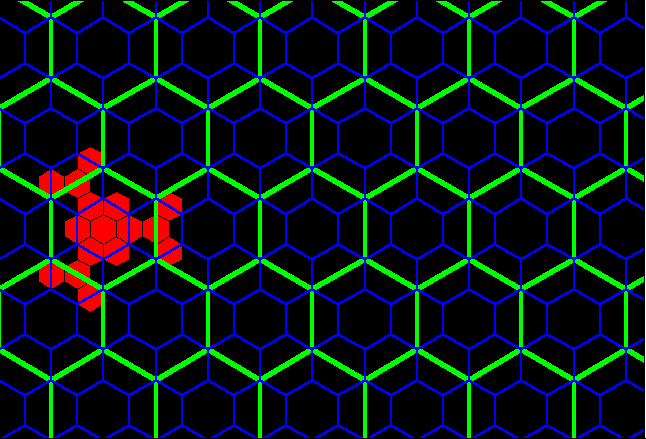
Figure
2.6c.
Red layer on tile from Figure 2.5 fits exactly to form classical K=4
landscape. |
The K=7 Hierarchy
When an hexagonal initiator is chosen and a three-sided generator, with
included angles of 120 degrees and shaped in a zig-zag form, is used to
make successive replacement of the sides of the hexagon (as in the
animated
Figure 2.7a), the outline of the next layer of the K=7 central
place
hierarchy is generated (the black lines in Figure 2.7a suggest interior
connections). The replacement sequence applies the generator in
an
alternating pattern to the outside and then to the inside of the
initiator.
When the original generator is scaled down, with shape preserved, and
applied
in the outside/inside sequence to the newly formed blue polygon, the
next
lower level central place K=7 hierarchy is formed (as in the
animated
Figure 2.7b). The second, blue polygon contains seven scaled-down
hexagons, self-similar to the first hexagon (Figure 2.7a); the red
polygon
in the animation sequence contains seven shapes self-similar to the
blue
polygon (Figure 2.7b), and 343 (or 7 cubed) hexagons self-similar to
the
original hexagon (Figure 2.7b). The invariant of 7, in the K=7
hierarchy, is replicated in this particular fractal iteration sequence.
.
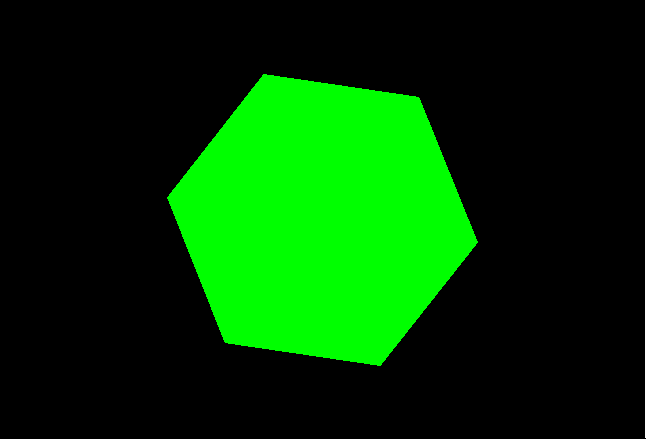
Figure
2.7a.
Animated K=7 fractal iteration sequence: first
transformation
using a three-sided fractal generator applied successively to sides of
the hexagonal initiator.
|
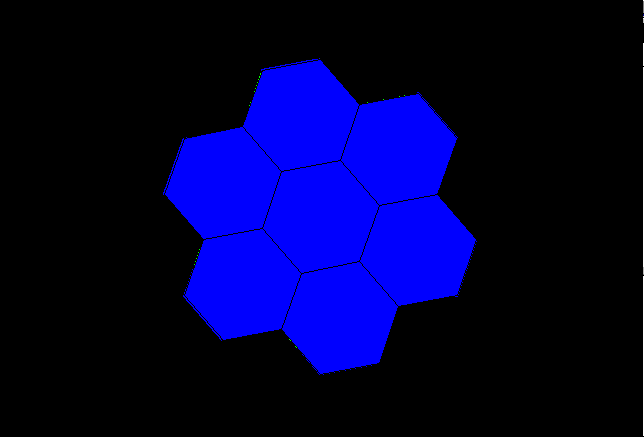
Figure
2.7b.
Animated K=7 fractal iteration sequence: second
transformation
using a scaled-down three-sided fractal generator applied successively
to sides of the blue polygon generated in Figure 2.7a. |
It
remains to determine if the polygons generated in Figure 2.7 will in
fact
fit together to form the broad central place landscape of arbitrary
size
suggested in
Figure
1.9. To that end, we stack the layers generated above using
the
fractal iteration sequence to form a tile of layers centered on the
single
polygonal initiator (Figure 2.8). Click
here
to see a virtual solid model of the tile with which the reader can
interact.
Click
here
to see a virtual translucent model of the tile with which the reader
can
interact. Consider
the screen captures below from those virtual reality models.
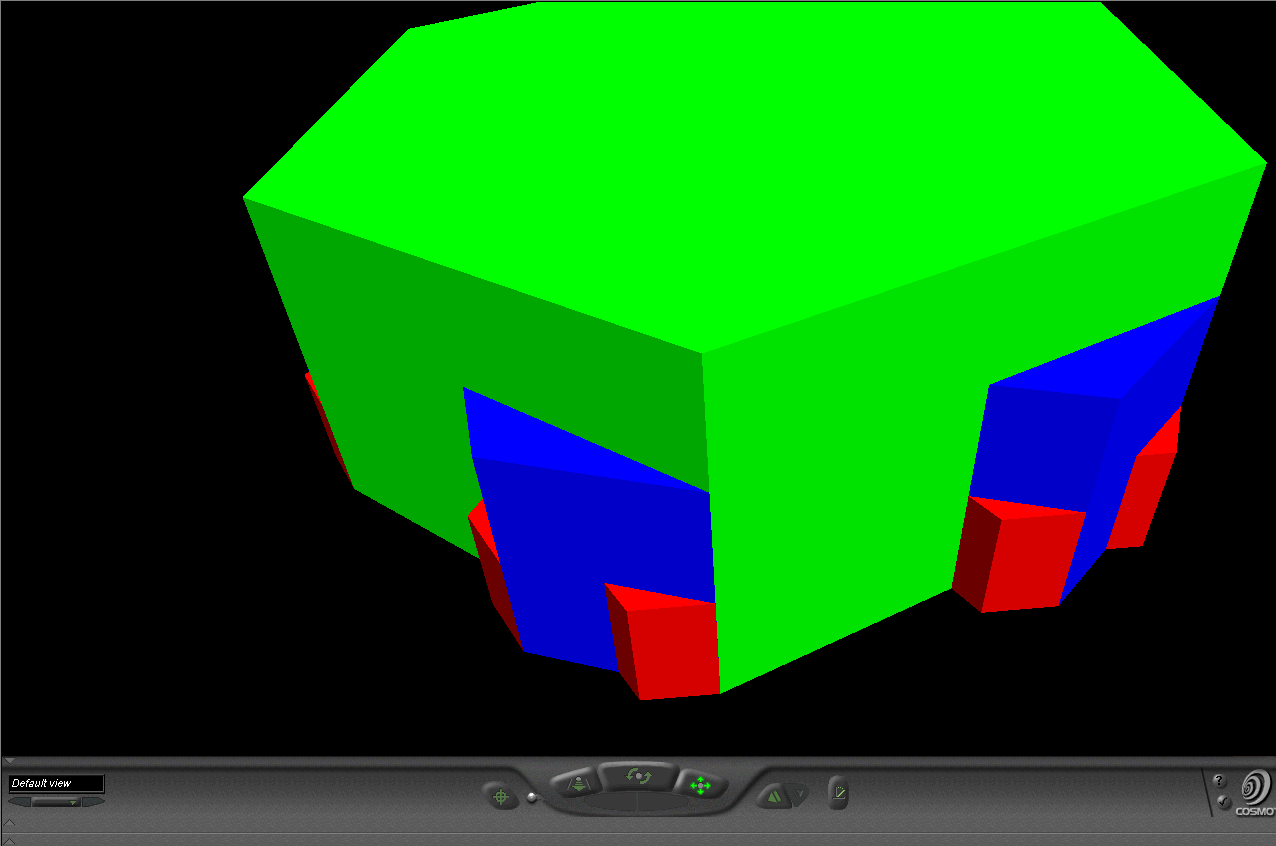
A screen shot
from
the virtual world linked to this image. Click on the image to
enter
that world! |
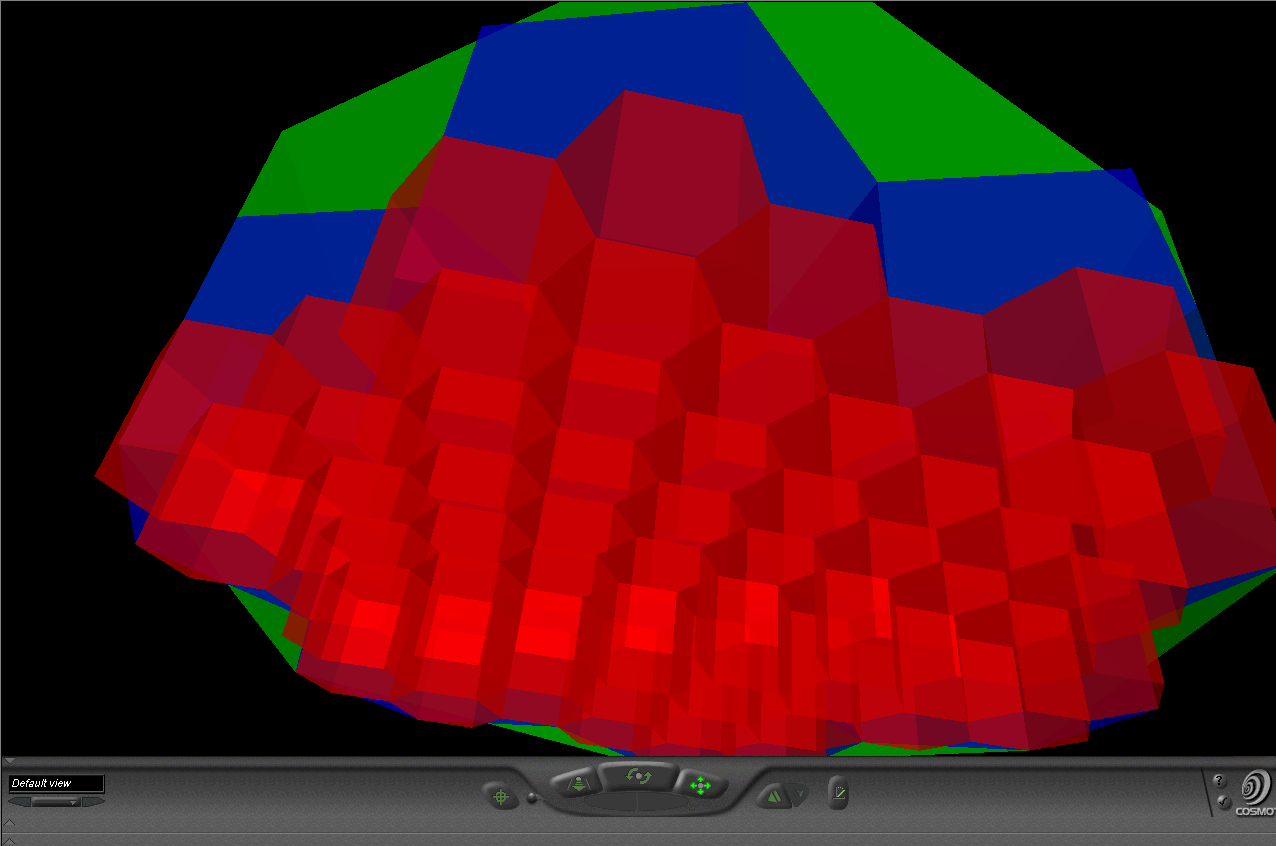
A screen shot
from
the virtual world linked to this image. Translucent solids permit
one to see relationships among layers of the hexagonal hierarchy while
travelling through the solids. Click on the image to enter that
world:
blast off in this virtual hexagonal space ship! |
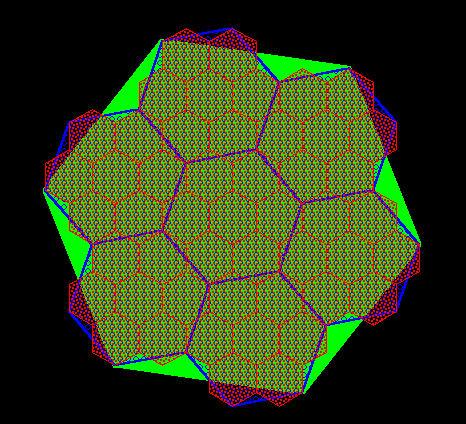
Figure 2.8.
Fractally generated layers stacked on a single hexagonal tile.
Click
here
to see a virtual solid model of the tile with which the reader can
interact.
Click here
to see a virtual translucent model of the tile with which the reader
can
interact. |
Finally,
we tile the plane using the hexagonal initiators, from Figure 2.8 with
the attached stack of smaller hexagons, to discover if the superimposed
structure also fits together perfectly (Figure 2.9). Hexagonal
tiles
are used to cover the plane without gaps, as is the case with the
sample
of green hexagons in Figure 2.9a. The hexagons mesh perfectly to
cover the plane (Theorem of Gauss).
In Figure 2.9b, the green outline of the hexagons remains. Each
of
the solid green hexagons has had the fractal generator above applied
and
the consequent superimposed blue tiles come into view sequentially in
this
animation. Again, the fit is exact, as we had hoped it might
be.
Finally, in Figure 2.9c, the blue outline only is retained from Figure
2.9b (along with the green outline from Figure 2.9a). The final
fractally
generated layer derived from the blue polygons of Figure 2.9b comes
into
view in shades of red (or yellow/gold for contrast). The final
layer
of hexagonal base of unit hexagons appears last. The fit is
perfect:
each green hexagon contains the equivalent of four blue hexagons and
each
blue hexagon contains the equivalent of four red hexagons. The
fractal
generation procedure created exactly the classical central place
landscape
of Figure
1.9 (return here using the Back button on your
browser).
As the animation proceeds in Figure 2.9, further layers of the
fractally
generated hierarchy, attached to the tile in Figure 2.8, come into view
illustrating an exact meshing of tiles at all levels to form a K=3
hierarchy.
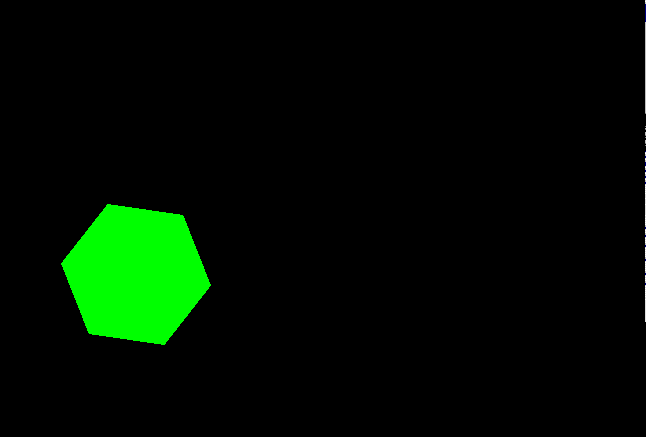
Figure
2.9a. Green layer on tile
from
Figure 2.8 fits exactly to tile the plane (Theorem of Gauss). |
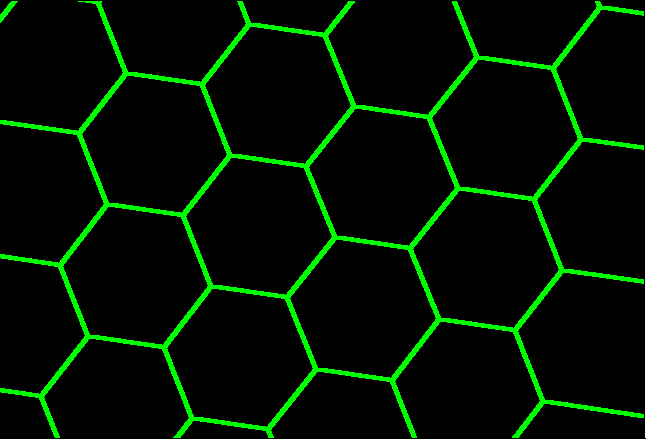
Figure
2.9b.
Blue layer on tile from Figure 2.8 fits exactly to form classical K=7
landscape. |
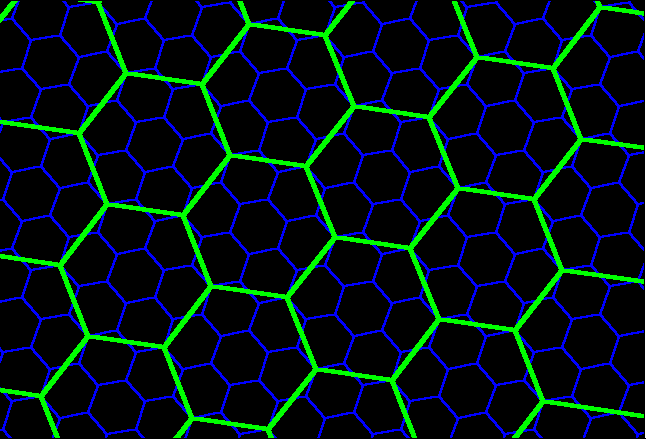
Figure
2.9c.
Red layer on tile from Figure 2.8 fits exactly to form classical K=7
landscape. |
Thus, the complex mechanics of
classical
central place theory come alive as a single dynamic system when viewed
using fractal geometry. The fit is exact.
The added role of
the fractional dimension
A fractal
iteration sequence, such as those above but carried out infinitely,
might
be thought to increase the extent to which a line "fills" space.
Mandelbrot captures this notion
of space-filling with the concept of fractional dimension (hence
"fractal").
He uses Hausdorff-Besicovitch dimension to measure the enduring
mathematical
concept of space-filling (see bibliography). We employ
Mandelbrot's
formulation for fractional dimension D as,
D=log(number of
generator sides)/log(square root of K). Thus, the
following
values for fractally-generated central place hierarchies emerge:
-
K=3, D=log2/log
 = 1.2618595
= 1.2618595
-
K=4, D=log3/log
2
= 1.5849625
-
K=7, D=log3/log
 = 1.1291501
= 1.1291501
The idea with the space-filling is to pick
an arbitrary point in the bounded space containing the curve.
Place
a circle of arbitrarily small radius around that point. Does that
circle contain a point on the curve as the fractal iteration sequence
goes
to infinity? If that is the case for any point, then the curve is
said to fill space and have dimension 2. If not, then there are
holes
or gaps (perhaps of infinitesimal size) in the space and the curve
fails
to fill space completely and has fractional dimension between 1 and 2
(as
a sort of Swiss cheese with holes). Thus, the K=4 fractal
iteration sequence, if permitted to repeat infinitely, has the highest
fractional dimension of these three: this curve gets "closer" to
arbitrary points in space than do the lines of the other hierarchies,
as
one might hope a hierarchy interpreted as a "transportation" hierarchy
would. The fractional dimension of the fractal iteration sequence
corresponds to the intuitive notion of scholars over time as to
interpretation:
another benchmark or field test of theory. The K=7
fractal
iteration sequence, if permitted to repeat infinitely, has the lowest
fractional
dimension of these three, keeping control from the center optimized and
hence supporting the "administrative" or "separation" interpretation
often
given to the classical K=7 hierarchy. Finally, the K=3
falls between: marketing needs greater spatial penetration than
does
administration but less than does transportation. Here, the fit
between
classical interpretation and fractal calculation is reasonable (one
could
never say "exact" because the terms "marketing," "transportation," and
"administrative" are inexact terms themselves).
What is difficult
with
fractals is to visualize the infinite process. Graphic color
display,
including three dimensional display, offers exciting strategies for
visualization.
Very quickly, however, it becomes difficult to draw the fine lines
required
by repeating the process at more and more local scales: physical
lines have width. Electronic lines can be controlled and made
finer
than can pen lines, but eventually the line-width limits the capability
to produce graphic images. Eventually, the mind's eye must take
over
and extrapolate the visual infinite process.
Another possibility
might be to draw on the other human senses to aid in that
extrapolation.
Thus, Figure 2.10 shows figures generated by Fractal
Music 1.9; click on the images and hear the associated music. The
left
figure shows the cellular automata base generated by default--it is
bilaterally
symmetric about a central vertical line and was generated using a
symmetrically
arranged initiator string of 64 digits ranging in value from 0 to 7
(one
for each tone). The next figure,
K=3, shows the cellular automata
diagram (another sort of "bubble foam" in appearance) generated using
the
value for the fractional dimension of the K=3 hexagonal
hierarchy
carried out to 64 decimal places as the initiator string for the
music.
The next figure, K=4, shows the cellular automata diagram
generated
using the value for the fractional dimension of the K=4
hexagonal
hierarchy carried out to 64 decimal places as the initiator string for
the music. The final figure, K=7, shows the cellular
automata
diagram generated using the value for the fractional dimension of the K=7
hexagonal hierarchy carried out to 64 decimal places as the initiator
string
for the music. Click on each figure to hear the music. Each
musical sequence, of over 1000 steps, was created from the default
base,
changing only the initiator string, so that the fractional dimension is
what operates on a "seed" value of basic notes. The listener
should
hear the basic pattern in all characterizations: great symmetry
in
the base value; abrupt changes of state in the K=3 value; a
smoother
filling of musical space in the K=4 music; and, gaps in the K=7
musical characterization derived from the K=7 fractional
dimension.
The bilaterally symmetric bubble-foam figure associated with the base
has
been skewed by each of the K-values, as has the corresponding
music.
Thus, we extend visualization from two dimensional graphical images to
three dimensional graphical images to the mind's eye, and finally, to
the
mind's ear: capturing hierarchical pattern through 1000 steps or
more is easy in the musical clips. Such characterization offers added
capability
to those of us with all of our senses that are functional: for
those
with limited visual sensory function, it offers a way to an auditory
"visualization"
of the beauty of geometry.
Figure 2.10. Fractal music
connection.
Click on the images generated by the fractional dimensions of the
hexagonal
hierarchies; compare these to the default base created by the software.
In subsequent chapters, we offer
mathematical
proof of these ideas and extensions of these ideas into new
realms.
The classical is used for alignment of new with the old: a
strategy
useful in a wide range of theoretical and applied research.
Institute
of Mathematical Geography. Copyright, 2005, held by authors.
Spatial Synthesis:
Centrality and Hierarchy, Volume I, Book 1.
Sandra Lach Arlinghaus and
William Charles Arlinghaus



























